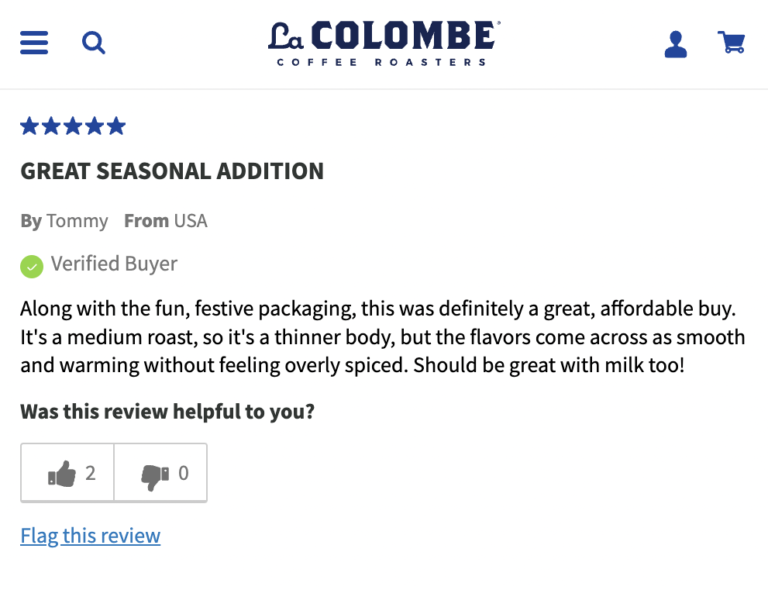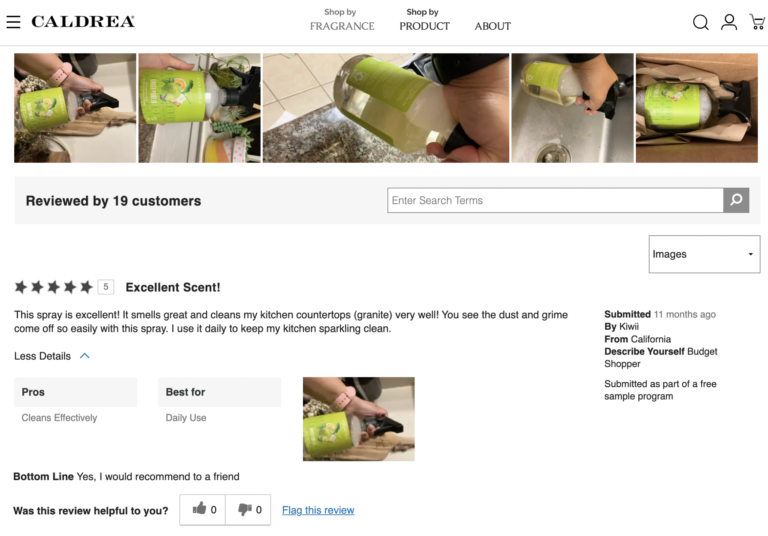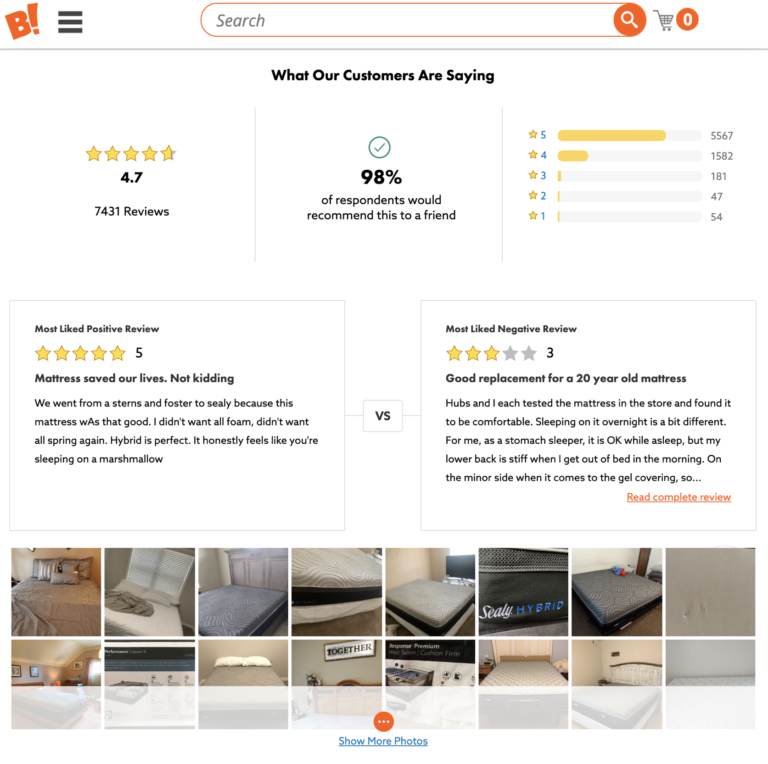Survey at a Glance:
How Fake Reviews Destroy Consumer Trust is based on the responses of 12,866 consumers in the US who completed a survey during the month of August 2022. Here’s a high level look at the key findings.
- When reading product reviews, 81% of US consumers are concerned about fake reviews.
- 63% of shoppers say they’re more concerned about fake reviews while shopping online than they were five years ago.
- Consumers are concerned about fake reviews across all ecommerce sites. However, there’s one site where concern is particularly high: Amazon. 84% of US consumers are concerned about fake reviews on Amazon.
- 90% of consumers in the US believe they’ve read a fake review in the past.
- Certain factors make consumers suspicious that a review might be fake. Wording, extremity, and a lack of detail top the list of fake review red flags.
- Disclosing the source of reviews positively impacts shoppers’ perception of a review.
- Tags that are particularly impactful include verified buyer (69%), verified reviewer (56%) and review submitted as part of a sampling campaign (43%).
- 54% of US consumers indicate that if a review is too extreme (either positive or negative), it makes them suspect it may be fake.
- Just 6% of US shoppers feel that the ideal average star rating for a given product is a perfect five out of five.
- 44% think the ideal star rating for a product they’re considering is between 4.5 and 4.99; 42% think it’s between 4.0 and 4.49.
Introduction
There was a time when consumers sought out feedback by asking for recommendations from family and friends. While word of mouth is still regarded as valuable by some, modern consumers more often seek out this type of feedback at scale – by reading reviews.
The feedback they uncover in those reviews has a large impact on purchase behavior. In fact, research tells us reviews have become the most important factor impacting purchase decisions.
The value of reviews is rooted in their authenticity. When consumers write reviews, they’re not doing so to sell products. They’re contributing content simply to share their genuine feedback – whether good, bad, or somewhere in between.
Yet, one simply needs to do a Google news search for “fake reviews” to see that the authenticity and trustworthiness of reviews is being called into question.
Fake reviews have become more common than you may like to think – especially on certain platforms. And some brands have even gone so far as to suppress negative reviews in an effort to improve consumer perception. Just earlier this year, the Federal Trade Commision (FTC) fined clothing retailer Fashion Nova $4.2m for doing just that.
In the short term, suppressing negative reviews and publishing fraudulent ones can be a quick way to improve a brand’s image – and grow sales. But in the end, these practices cause lasting damage.
Phony reviews mislead customers. This leads to poor purchase decisions – and unhappy customers.
What’s more, when a brand or retailer is found out (notice we said when, not if) for these unsavory practices, it can cause irreparable damage to their reputation. If consumers don’t feel they can trust a company, they’re unlikely to make a purchase.
Brands and retailers must be focused on preserving the authenticity of reviews. But why is this so important? And what actions can they take to do so?
PowerReviews recently surveyed nearly 13,000 US consumers to understand their growing concern with fake reviews – as well as key actions brands and retailers can take to preserve their authenticity. In this report, we’ll explore the key findings.
Research Methodology
The report that follows is based on an analysis of 12,866 US consumer responses to a survey from August 2022. Here’s a snapshot of who completed the survey.
Generations
(1997-present)

(1981-1996)

(1965-1980)

(1946-1964)

Household Income
Average Monthly Spending
Shoppers’ Concern with Fake Reviews
Consumers of all Ages are Concerned with Fake Reviews
When reading product reviews, just over eight in 10 (81%) US consumers are concerned about fake reviews. Concern is fairly steady across all generations.
Also of note, US consumers are less concerned about fake reviews than those in the UK. Our previous research found that 90% of shoppers in the UK are concerned about fake reviews.
We asked respondents to rank their concern with fake reviews on a scale of one to five (with one being the least concerned and five being the most concerned). The average response was 3.00, compared to an average ranking of 3.22 for consumers in the UK.
But make no mistake: fake reviews are a concern for US consumers. After all, 85% rank their level of concern as three or higher.
Concern with Fake Reviews is Growing
Fake reviews have always been a concern. But headlines in the past few years have made this fraudulent content top of mind for consumers. The majority (63%) are more concerned about fake reviews when shopping online than they were five years ago. In fact, concern is growing among consumers of all ages.
US Consumers are Particularly Concerned with Fake Reviews on Amazon
There have been plenty of news articles in the recent past about the prevalence of fake reviews on Amazon. So it probably comes as no surprise that Amazon.com tops the list of sites where consumers in the US are concerned about fake reviews. This is also the case for consumers in the UK.
The Ubiquity of Fake Reviews – and What Tips Shoppers Off
How common are fake reviews? And what red flags do shoppers look for to determine if a review is phony?
Nearly all Consumers Have Stumbled Upon a Shady Review
Fake reviews have become all too common. Nine in 10 (90%) US consumers believe they’ve read a fake review in the past. This is slightly higher than in the UK, where 87% of consumers believe they’ve read a fake review.
Of note, Gen Z and Boomer shoppers are slightly less likely to suspect they’ve encountered fake reviews than Millennials and Gen X.
In addition, the higher the household income of a respondent, the more likely they are to suspect they’ve encountered fake reviews. This is likely because those with higher incomes shop online more – and thus have more opportunities to encounter fake reviews.
How US Shoppers Pinpoint Fraudulent Reviews
Most shoppers in the US believe they’ve seen fake reviews in the past. But what factors lead them to believe a review isn’t authentic?
The top factor is the wording of the review or how it’s written. This factor also tops the list among UK shoppers.
Other red flags include poor grammar, extremeness (either too positive or too negative), and a lack of specific detail.
How to Preserve Review Authenticity and Shopper Trust
Fake reviews are common – and that’s a big problem. After all, the presence of even a single fake review can tarnish a shopper’s trust – perhaps forever.
As such, brands and retailers must make it a top priority to preserve the authenticity of reviews.
Transparency About Review Source Boosts Trust
Reviews can come from a variety of different sources. For example, one review might be written by someone who received a free sample – while another was written by someone who purchased the product on their own.
One important way to preserve the authenticity of reviews is to be transparent about their source. Brands and retailers can do this by adding text or a “tag” to each review – which lets shoppers know the source.

It probably comes as no surprise that the “verified buyer” tag is the tag that has the largest impact on US consumers’ perception of a review. After all, such a tag is proof positive that the shopper has actually purchased the product in question.
Shoppers Can See Through Perfect Star Ratings
Negative reviews are never the goal for brands and retailers. But a lack of negative content can raise suspicions among shoppers. As mentioned earlier in this report, if a review is too extreme – whether positive or negative – it raises red flags for over half of shoppers. In addition, a previous survey found that nearly half (46%) of consumers are leery of products with a perfect average star rating of five out of five.
Our most recent research confirmed that perfect average star ratings are rarely ideal. A mere 6% of shoppers indicate that 5.0 is the ideal average star rating for a product. The largest portion of consumers – 44% – feel that the ideal average star rating falls between 4.5 and 4.99. 42% think the sweet spot sits between 4.0 and 4.49 stars.
Again, negative reviews shouldn’t be the goal. However, there is a positive side to them. For starters, negative reviews are an important tool many shoppers depend on to make the best purchase decisions.
Research tells us that 61% of consumers actively seek out one-star reviews. Doing so helps them determine the worst case scenario – and whether it’s something they can live with.
In addition, displaying negative reviews shows your shoppers you have nothing to hide. That transparency boosts trust – and purchase likelihood.
5 Key Takeaways for Brands and Retailers
These days, nearly all consumers consult reviews. But fake reviews and manipulated review footprints threaten authenticity – and consumer trust. Brands and retailers must make it a top priority to preserve the authenticity of reviews.
These are the top five takeaways from our latest survey on review authenticity.
Reviews have become a key part of the purchase journey. In fact, research found that reviews are the top factor impacting purchase decisions.
Yet, there’s growing concern about fake reviews. Over eight in 10 (81%) US consumers are concerned with fake reviews. And 63% are more concerned about fake reviews now than they were a mere five years ago. Amazon is the site consumers are most concerned about fake reviews.
Nine in ten (90%) of consumers believe they’ve come across a fake review in the past. They identify fake reviews by looking for certain red flags, including wording, extremity, and a lack of specific details.
Your ratings and reviews platform should have a robust moderation process in place to spot phony reviews so they never see the light of day. Be sure to ask about it.
Consumers value reviews because it’s authentic content provided by others like them – rather than a brand trying to make a sale. One key way to preserve trust is to leverage badges that disclose the source of reviews.
For example, consider adding a badge indicating when a review was written by a verified buyer – or when a shopper received a free sample or some other incentive. For many shoppers, these badges positively impact their perception of the given review.

Over half of US consumers (54%) say that if a review is too extreme – whether positive or negative – that makes them think it might be a fake. What’s more, a mere 6% feel that the ideal average star rating for a product is a perfect 5.0.
Consumers know that a single product can’t be all things to all people. So when they see all glowing reviews for a product, it makes them suspicious. Of course, it’s important to have a moderation process in place that flags fraudulent or inappropriate reviews. But such a process shouldn’t suppress reviews simply because they’re negative.
Negative reviews are an important tool consumers use to make informed purchase decisions. Display negative reviews – and add features to your review display that make it easy for shoppers to find them. By doing so, you’re helping your shoppers find the products that best fit their needs – while showing them you have nothing to hide.

Sure, there are certain red flags that can help you determine if a given review is fake. But preserving review authenticity at scale can be a challenge – especially considering how prevalent fake reviews have become.
If review authenticity is a priority (and it should be), turn to the experts. Here at PowerReviews, we have a comprehensive fraud detection process that combines technology and human moderation. With this process, you can keep fraudulent content off your site – and preserve the trust you’ve worked hard to earn.


